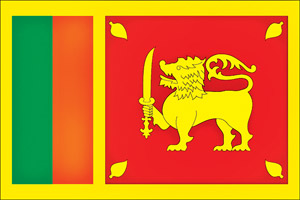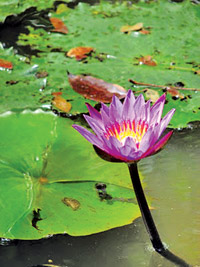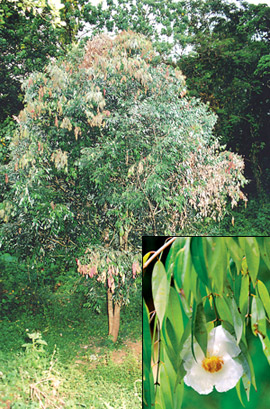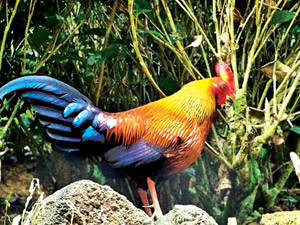Our national symbols...
National Flag
Every country has a national flag and many of you must be familiar
with most of these flags which come in various sizes, shapes and colours
depicting different designs and symbols.
Our national flag which depicts a sword bearing lion, two green and
yellow strips and Bo leaves which is hoisted at all national functions
however, is not the original flag that was unfurled at the first
Independence Day celebrations in 1948.

The need for such a national flag was discussed and eventually a
motion was also tabled in the State Council by the then MP for
Batticaloa, A. Sinnalebbe on January 16, 1948, stating that the Lion
flag used by our last king. Sri Wickrama Rajasinghe (which was taken to
Britain way back in 1815) should become our national flag.
But there was disagreement and so, the Prime Minister D. S.
Senanayake appointed a national Advisory Committee to look into this.
But, as no final decision for a different flag was made, the Lion flag
fluttered at the Independence celebrations in 1948.
The Prime Minister unfurled the Lion flag at the opening of the first
Parliament of Independent Ceylon (as it was then known) on February 11,
1948 and it fluttered alongside the British Union Jack. Then again it
was unfurled at the Octagon (Pattirippuwa), Kandy during Independence
Day celebrations held there on February 12, 1948. The national flag that
we have today which was recommended by the special committee was
presented to Parliament by Premier D. S. Senanayake and was adopted only
on March 2, 1951’. The special advisory committee members comprised S.
W. R. D. Bandaranaike (Chairman), Sir John Kotalawela, J. R.
Jayewardene, T. B. Jayah, Dr. L. A. Rajapaksa, G. G. Ponnambalam and
Senator S. Nadesen and Dr. Senarath Paranavithana (Secretary). As
recommended by the committee on March 2, 1951 two strips of green and
saffron yellow (each strip equal to one-seventh the size of the flag)
was added to the original Lion flag along with the other symbolic motifs
and designs we see today.
However, when Sri Lanka became a republic in 1972, the stylised Bo
leaves were replaced with natural Bo leaves. It was the amended flag
that was unfurled at the Republic Day celebrations on May 22, 1972. The
flag which was designed with great care retaining the original design of
the Lion flag, the civil standard of King Sri Wickrama Rajasinghe, not
only represents the heritage of the country but also integrates the
minority races into the majority race.
The lion which is symbolic of bravery represents the majority
Sinhalese ethnic strength while the saffron vertical strip represents
the Tamils, the green strip the Muslims and Moors. Crimson background,
the European Burghers and the yellow border other minority ethnicities.
Each part of the lion has a different meaning.The Bo leaves represent
kindness, friendliness, happiness and equanimity (metta, karuna, muditha
and upeksha).
The national flag should be treated
with respect and not just thrown around as just another piece of cloth
or paper.
National Anthem
Ananda Samarakoon’s composition ‘Namo Namo Matha’ is our national
anthem which should be sung with great pride and reverence. The main
theme of the anthem is designed to instil honour and respect to our
Motherland and also create national development through unity.
Do you know that a competition to select a national anthem was
conducted in January 1948 on the recommendation of the Sri Lanka
Gandharva Sabha and Samarakoon’s composition was selected on November
22, 1951 However, as there was some controversy about the lyrics, the
opening words in Samarakoon’s composition, were changed to “Sri Lanka
Matha - Apa Sri Lanka...”
On Independence Day in 1952, a group of 500 students from Musaeus
College rendered the national anthem for the first time and it was
broadcast over the radio.
National Emblem
 Even
after we gained independence we continued to use the British emblem, but
a select committee was later appointed to devise a new State emblem. Even
after we gained independence we continued to use the British emblem, but
a select committee was later appointed to devise a new State emblem.
Initially it had a lion with a sword in its right fore paw encircled
by a palapethi open petal design at the top. A strip carrying our
country’s name in all three languages was at the bottom.
When we became a Republic in 1972 a new emblem was chosen. Retaining
the original design, a punkalasa, the dhammachakka, sun, moon and two
sheaves of paddy were added to make the State emblem what it is today.
 National
Flower National
Flower
The beautiful fragrant and star-like blossom of the lily family, the
blue water lily (Nymphaea stellata) or the Nil Manel as it’s known in
Sinhala was selected as the national flower of our Motherland in
February 1986.
The lily which has several bluish-green petals arranged like a star
and flat, round waterproof leaves grows in the shallow water in all
parts of the country.
It is considered to be a symbol of purity and truth. Buddhists and
Hindus use these flowers for religious purposes.
 National
Tree National
Tree
The ironwood (Mesua ferrea) or the Na tree which is a rainforest tree
indigenous to the lower Wet Zone of the country was named the National
Tree in 1986. This tree which grows to about 30 feet in height has a
radiant white flower with a golden centre which is used by many Buddhist
devotees as offering to the Buddha. The beautiful bright red leaves,
mature to a deep green.
The wood of this tree is hardy and has been used to construct even
bridges, but the reason it was chosen as our national tree is not
because of its hardiness, but its religious connection. It is believed
that the Buddha’s first visit to Mahiyanganaya was to a grove of Na
trees and also that the next Buddha, will attain enlightenment under a
Na tree.
National Bird

The bright brown hued fowl, the Ceylon Jungle Fowl (Gallus lafayetti),
known as the Wali Kukula in Sinhala has been elevated to national
status.
It can be found strutting about and scratching the ground for food in
typical fowl fashion, in many parks of the country. |

